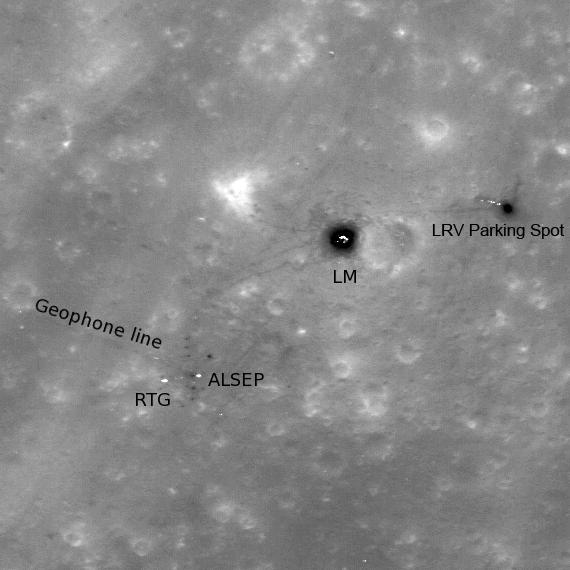
WIKIARCHIVES.SPACE
The Human Spaceflight Archive

High-sun image of the Apollo 16 landing site showing the lunar module descent stage, various pieces of equipment, and disturbed lunar soil (seen as darker lines and areas) which marks where John Young and Charles Duke traversed in the spring of 1972. LROC image M109134835L, 296 meters, or 971 feet, across.
Information
- Taken in
- Author
- NASA/GSFC/Arizona State University
- Description
-
High-sun image of the Apollo 16 landing site showing the lunar module descent stage, various pieces of equipment, and disturbed lunar soil (seen as darker lines and areas) which marks where John Young and Charles Duke traversed in the spring of 1972. LROC image M109134835L, 296 meters, or 971 feet, across.
The lunar module Orion landed in the Descartes highlands of the Moon on 21 April 1972. The Apollo 16 mission targeted a highland region. Originally thought to be a volcanic site, the samples returned by Apollo 16 actually indicated that the highlands of the Moon primarily consist of impact-formed rocks (breccias), a substantial scientific result.
NASA's Goddard Space Flight Center built and manages the mission for the Exploration Systems Mission Directorate at NASA Headquarters in Washington. The Lunar Reconnaissance Orbiter Camera was designed to acquire data for landing site certification and to conduct polar illumination studies and global mapping. Operated by Arizona State University, LROC consists of a pair of narrow-angle cameras (NAC) and a single wide-angle camera (WAC). The mission is expected to return over 70 terabytes of image data.
- Created on
- Thursday 8 July 2010
- Albums
- US SPACE PROGRAM / PROBES / MOON / LRO/LCROSS / Annoted/Science
- Source link
- https://photojournal.jpl.nasa.gov
- Visits
- 19
- Rating score
- no rate
- Rate this photo
- License
- Public Domain
- Modified by WikiArchives
- No (original)
- Downloads
- 1
Powered by Piwigo




